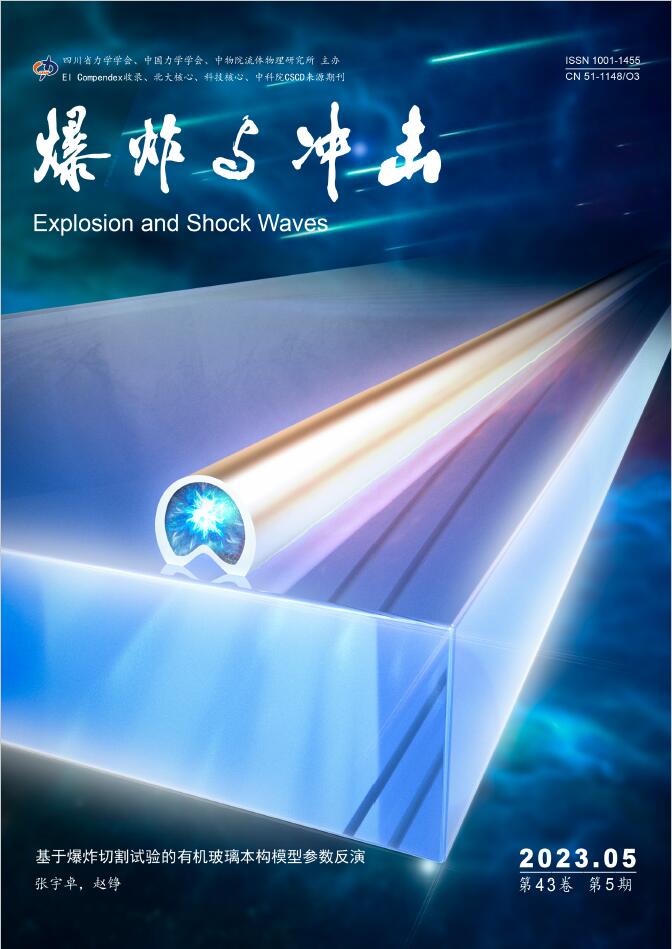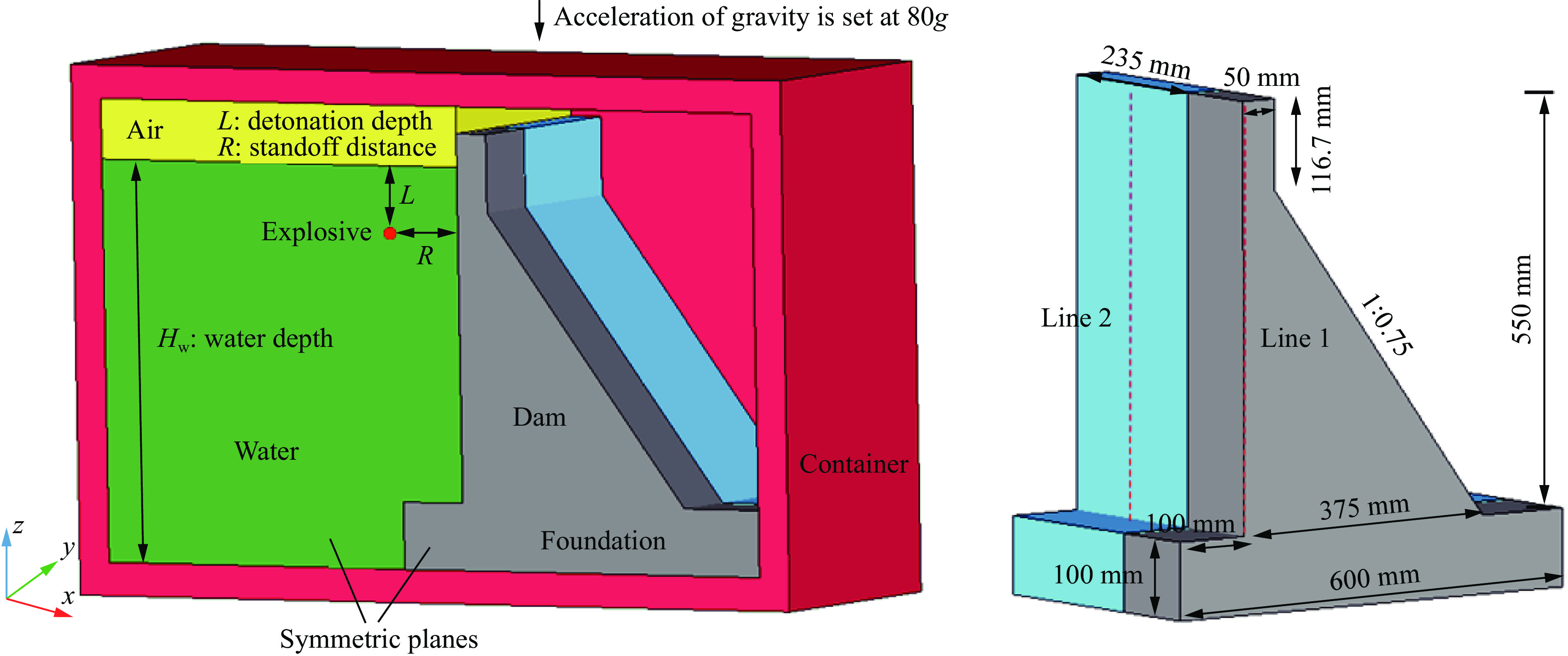| [1] |
WANG G H, ZHANG S R, KONG Y, et al. Comparative study of the dynamic response of concrete gravity dams subjected to underwater and air explosions [J]. Journal of Performance of Constructed Facilities, 2015, 29(4): 04014092. DOI: 10.1061/(ASCE)CF.1943-5509.0000589. |
| [2] |
WANG G H, LU W B, YANG G D, et al. A state-of-the-art review on blast resistance and protection of high dams to blast loads [J]. International Journal of Impact Engineering, 2020, 139: 103529. DOI: 10.1016/j.ijimpeng.2020.103529. |
| [3] |
CHEN Y Q, LV L M, WANG J H, et al. Review of blast resistance performance and protection of dams under blast shock load [J]. Protective Engineering, 2021, 43(2): 1–10. DOI: 10.3969/j.issn.1674-1854.2021.02.001. |
| [4] |
CHEN Y Q, LV L M, WANG G H, et al. Review on the blast-resistance performance evaluation of dams [J]. China Civil Engineering Journal, 2021, 54(10): 9–19. DOI: 10.15951/j.tmgcxb.2021.10.003. |
| [5] |
VANADIT-ELLIS W, DAVIS L K. Physical modeling of concrete gravity dam vulnerability to explosions [C]//2010 International Water Side Security Conference. Carrara: IEEE, 2010: 1-11. DOI: 10.1109/WSSC.2010.5730291. |
| [6] |
HUANG X P, HU J, ZHANG X D, et al. Bending failure of a concrete gravity dam subjected to underwater explosion [J]. Journal of Zhejiang University-Science A, 2020, 21(12): 976–991. DOI: 10.1631/jzus.A2000194. |
| [7] |
HUANG X P, KONG X Z, HU J, et al. Failure modes of concrete gravity dam subjected to near-field underwater explosion: centrifuge test and numerical simulation [J]. Engineering Failure Analysis, 2022, 137: 106243. DOI: 10.1016/j.engfailanal.2022.106243. |
| [8] |
HUANG X P, HU J, ZHANG X D, et al. Effect of bubble pulse on concrete gravity dam subjected to underwater explosion: centrifuge test and numerical simulation [J]. Ocean Engineering, 2022, 243: 110291. DOI: 10.1016/j.oceaneng.2021.110291. |
| [9] |
ZHANG S R, WANG G H, WANG C, et al. Numerical simulation of failure modes of concrete gravity dams subjected to underwater explosion [J]. Engineering Failure Analysis, 2014, 36: 49–64.
|
| [10] |
WANG G H, ZHANG S R, LU W B, et al. Damage effects of concrete gravity dams subjected to underwater explosion [J]. Journal of Hydraulic Engineering, 2015, 46(6): 723–731. DOI: 10.13243/j.cnki.slxb.20140908. |
| [11] |
LI Q, WANG G H, LU W B, et al. Influence of reservoir water levels on the protective performance of concrete gravity dams subjected to underwater explosions [J]. Journal of Structural Engineering, 2018, 144(9): 04018143.
|
| [12] |
WANG C, WEI P Y, WANG X H, et al. Blast-resistance and damage evaluation of concrete gravity dam exposed to underwater explosion: considering the initial stress field [J]. KSCE Journal of Civil Engineering, 2021, 25(8): 2922–2935. DOI: 10.1007/s12205-021-1650-0. |
| [13] |
ZHANG Q L, HU Y G, LIU M S, et al. Role of negative pressure in structural responses of gravity dams to underwater explosion loadings: the need to consider local cavitation [J]. Engineering Failure Analysis, 2021, 122: 105270. DOI: 10.1016/j.engfailanal.2021.105270. |
| [14] |
SHU Y Z, WANG G H, LU W B, et al. Damage characteristics and failure modes of concrete gravity dams subjected to penetration and explosion [J]. Engineering Failure Analysis, 2022, 134: 106030. DOI: 10.1016/j.engfailanal.2022.106030. |
| [15] |
ZHU J G, CHEN Y Q, LYU L. Failure analysis for concrete gravity dam subjected to underwater explosion: a comparative study [J]. Engineering Failure Analysis, 2022, 134: 106052. DOI: 10.1016/j.engfailanal.2022.106052. |
| [16] |
REN X D, SHAO Y. Numerical investigation on damage of concrete gravity dam during noncontact underwater explosion [J]. Journal of Performance of Constructed Facilities, 2019, 33(6): 04019066. DOI: 10.1061/(ASCE)CF.1943-5509.0001332. |
| [17] |
LV L M, CHEN Y Q, WEI X L, et al. Study of damage assessment method of concrete gravity dam based on damage-area ratio index [J]. Protective Engineering, 2020, 42(2): 28–32. DOI: 10.3969/j.issn.1674-1854.2020.02.005. |
| [18] |
LI Q, WANG G H, LU W B, et al. A rapid identification method for underwater explosion damage of a concrete gravity dam [J]. Journal of Vibration and Shock, 2020, 39(24): 46–53,62. DOI: 10.13465/j.cnki.jvs.2020.24.007. |
| [19] |
WANG X H, ZHANG S R, WANG C, et al. Blast-induced damage and evaluation method of concrete gravity dam subjected to near-field underwater explosion [J]. Engineering Structures, 2020, 209: 109996. DOI: 10.1016/j.engstruct.2019.109996. |
| [20] |
ZHANG S R, WANG G H, WANG C, et al. Failure mode analysis of concrete gravity dam subjected to underwater explosion [J]. Explosion and Shock Waves, 2012, 32(5): 501–507. DOI: 10.11883/1001-1455(2012)05-0501-07. |
| [21] |
ZHANG Q L, LI D Y, LI B. Damage propagation and failure mode of gravity dam subjected to underwater explosion [J]. Explosion and Shock Waves, 2012, 32(6): 609–615. DOI: 10.11883/1001-1455(2012)06-0609-07. |
| [22] |
WANG G H, ZHANG S R. Damage prediction of concrete gravity dams subjected to underwater explosion shock loading [J]. Engineering Failure Analysis, 2014, 39: 72–91. DOI: 10.1016/j.engfailanal.2014.01.018. |
| [23] |
HUANG X P, KONG X Z, HU J, et al. The influence of free water content on ballistic performances of concrete targets [J]. International Journal of Impact Engineering, 2020, 139: 103530. DOI: 10.1016/j.ijimpeng.2020.103530. |
| [24] |
ROSSI P. A physical phenomenon which can explain the mechanical behaviour of concrete under high strain rates [J]. Materials and Structures, 1991, 24(6): 422–424. DOI: 10.1007/BF02472015. |
| [25] |
HUANG X P, KONG X Z, CHEN Z Y, et al. Equation of state for saturated concrete: a mesoscopic study [J]. International Journal of Impact Engineering, 2020, 144: 103669. DOI: 10.1016/j.ijimpeng.2020.103669. |
| [26] |
KONG X Z, FANG Q, CHEN L, et al. A new material model for concrete subjected to intense dynamic loadings [J]. International Journal of Impact Engineering, 2018, 120: 60–78. DOI: 10.1016/j.ijimpeng.2018.05.006. |
| [27] |
ZHAO F Q, WEN H M. Effect of free water content on the penetration of concrete [J]. International Journal of Impact Engineering, 2018, 121: 180–190. DOI: 10.1016/j.ijimpeng.2018.06.007. |
| [28] |
XU H, WEN H M. Semi-empirical equations for the dynamic strength enhancement of concrete-like materials [J]. International Journal of Impact Engineering, 2013, 60: 76–81. DOI: 10.1016/j.ijimpeng.2013.04.005. |
| [29] |
HUANG X P, KONG X Z, CHEN Z Y, et al. Comparison of failure modes of concrete gravity dams by underwater explosion loads near the water free surface, the middle, and the bottom of the reservoir [J]. China Civil Engineering Journal, 2023, 56(3): 116–128. DOI: 10.15951/j.tmgcxb.21121206. |
| [30] |
GEERS T L, HUNTER K S. An integrated wave-effects model for an underwater explosion bubble [J]. The Journal of the Acoustical Society of America, 2002, 111(4): 1584–1601. DOI: 10.1121/1.1458590. |










 DownLoad:
DownLoad:















